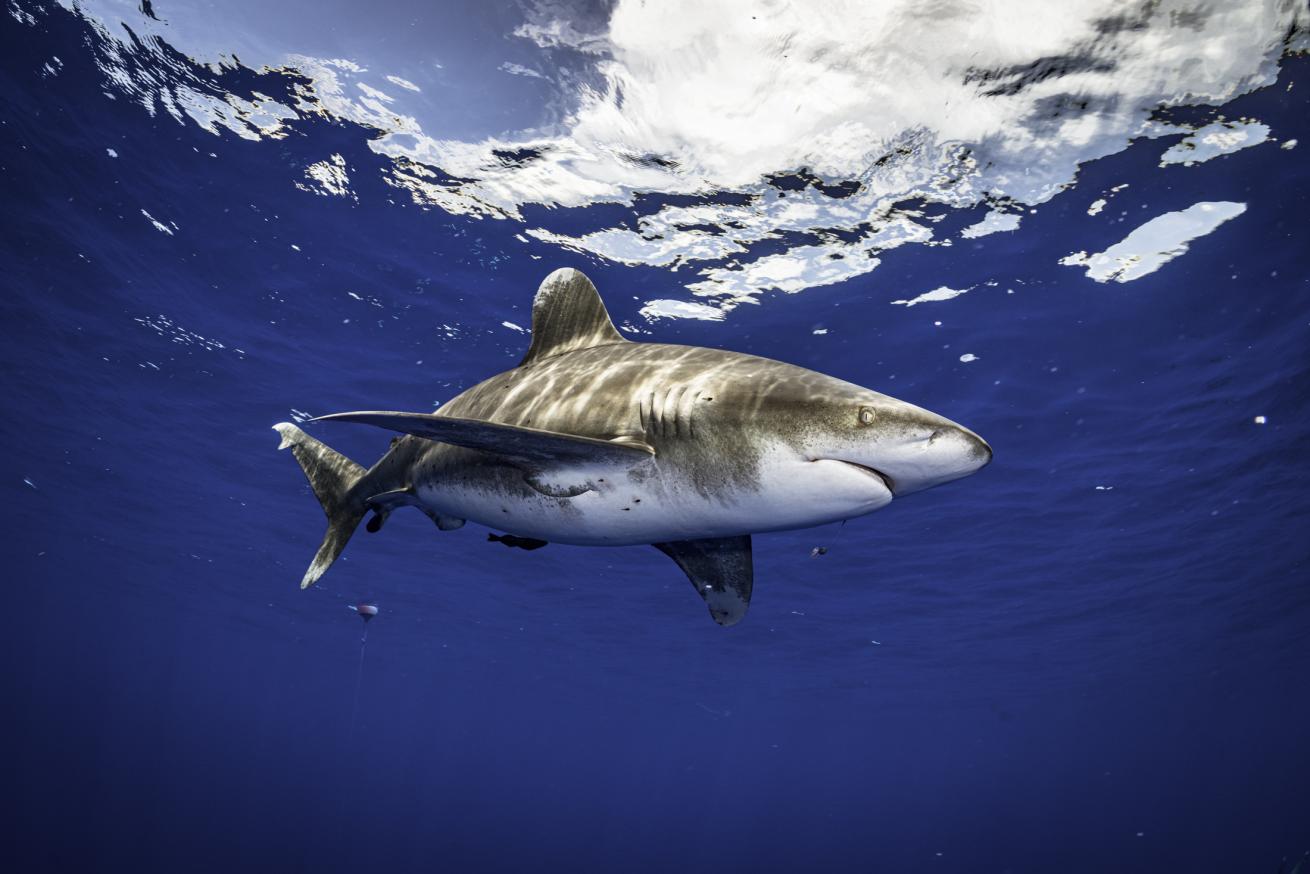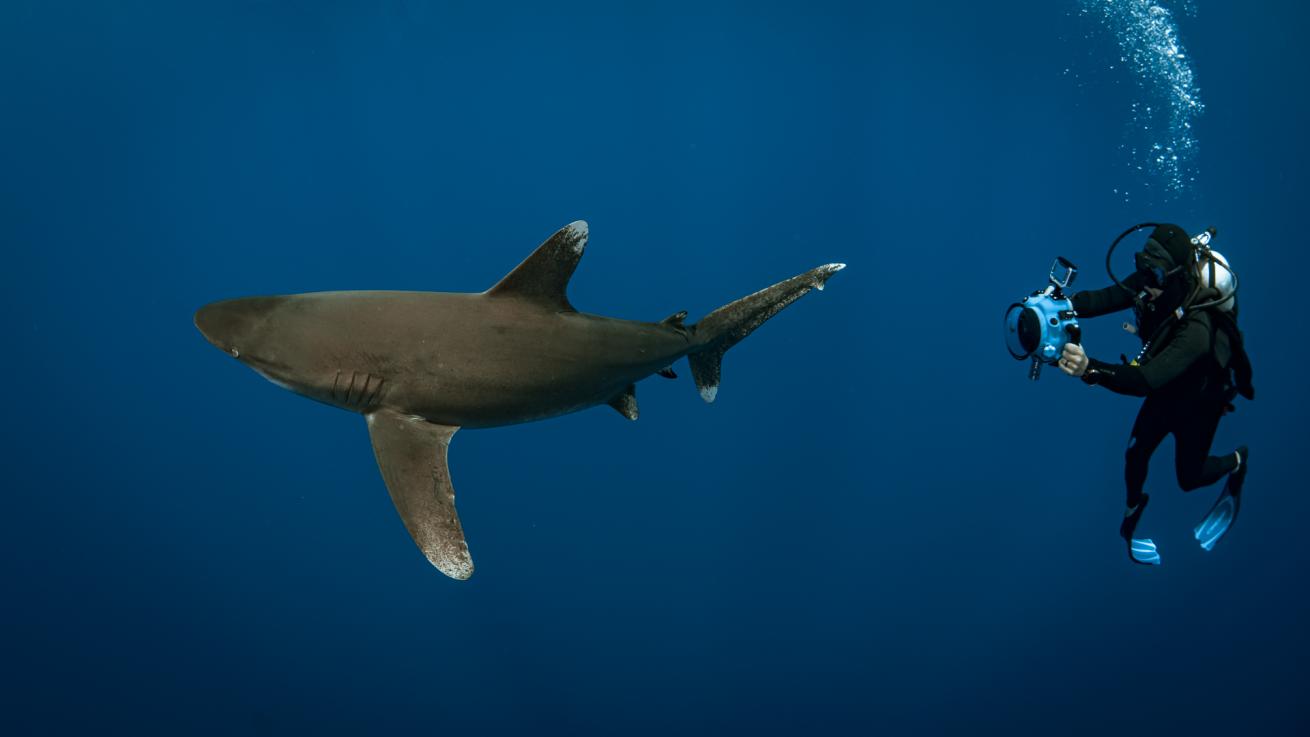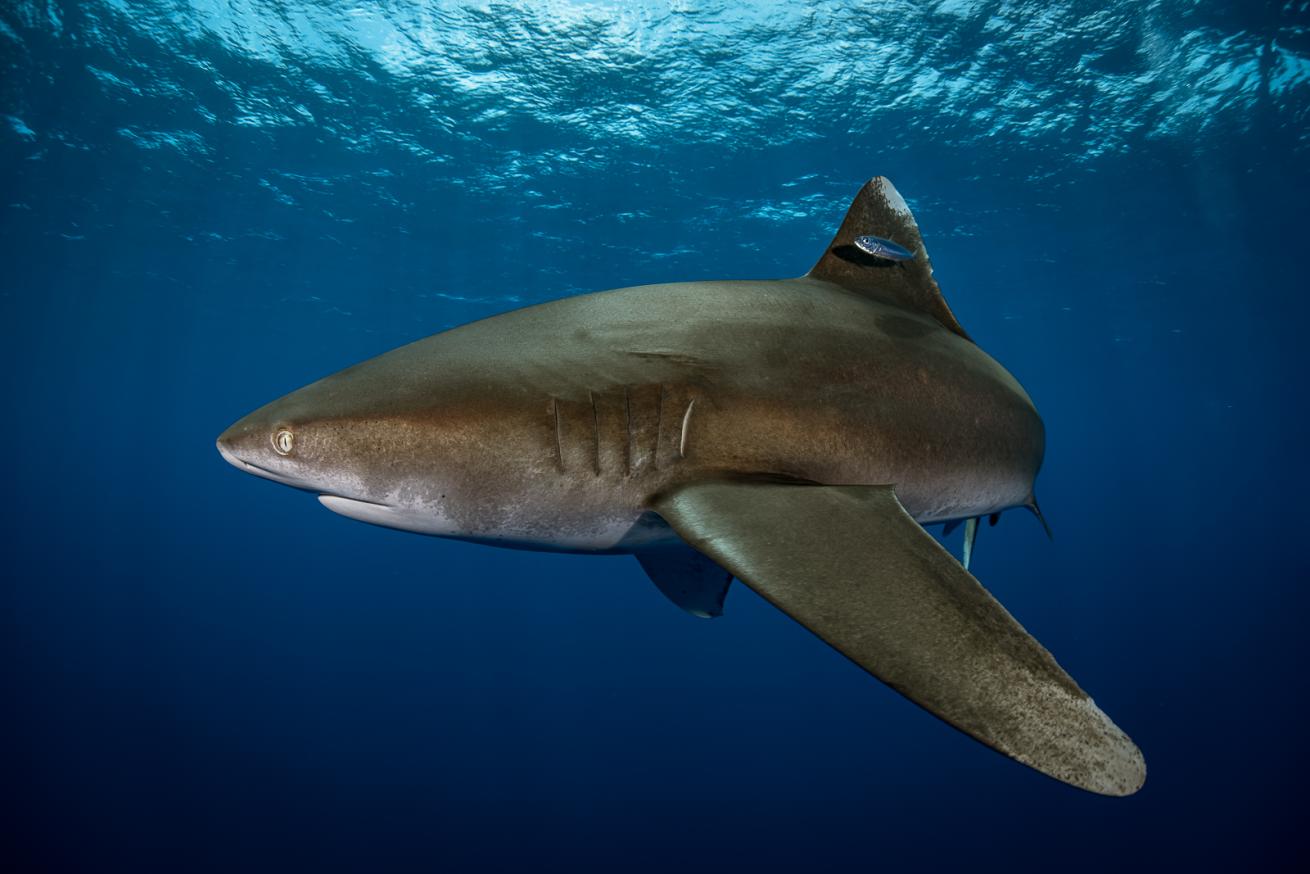How to Photograph Pelagic Sharks

By angling the camera upwards slightly we can pick up more of the surface texture to make our backgrounds a bit more interesting
There is something truly special about photographing sharks. Perhaps it's our curiosity about these ancient creatures that have been patrolling our oceans since before trees existed on land or maybe it’s our admiration of an apex predator that has endured five mass extinctions. These remarkable creatures are at the top of most underwater photographers’ bucket lists.
One of the more elusive and sought-after species is the oceanic whitetip shark (Carcharhinus longimanus). They have long pectoral and dorsal fins that are capped in a bright white, which gives them their spectacular, iconic look. Whitetips are incredible hunters and highly evolved for open ocean hunting, preying on everything from tuna to turtles, birds, and even giant squid.
In our "Ask a Pro Photographer" Instagram session, Mike (@ms.photography_lovetheocean) asked for tips on photographing oceanic whitetip sharks. While only a handful of places in the world offer the chance to see whitetip sharks, like Cat Island in the Bahamas and the Red Sea, many other pelagic shark species can be found at numerous global dive spots. So to make sure this advice reaches as many photographers as possible, many of the tips I provide apply to any pelagic shark species.

Keeping an eye on our buddy gives us a visual reference for safety, but we can also use them to show scale in our shots. You can see just how big this female oceanic is compared to my buddy Stan Moniz.
Situational Awareness
Allow me to start with a few side notes. I probably don’t need to say this, but working with experienced shark guides who utilize responsible practices is essential. Most pelagic sharks humans might encounter will be high-level open ocean predators and must be treated as such. No one would run off into grizzly bear territory without some precautions in place, and the same is true for whitetips, makos, blues or any other shark species.
When venturing into pelagic shark territories, we must remember entering their ‘forest’. Protocols and procedures may vary depending on the species, so paying close attention to the guide’s briefing is crucial. In general, it’s best to keep your head on a swivel and avoid spending too much time staring at your camera screen. Use your peripheral vision to set up shots while staying alert to the sharks’ location. Oceanic whitetips, for example, love to come in from behind divers. On blue water scuba dives, use your buddy as a visual reference to ensure you aren’t sinking lower than the rest of the group.
Related Reading: World's Best Destinations for Underwater Photography
Camera Settings and Lenses
When photographing pelagic sharks, it's best to use a wide-angle lens. For a full-frame camera, lens options like a 16-35 mm rectilinear or a 15 mm fisheye work well, depending on the species you photograph. I love Nauticam’s WACP-1 for its excellent zoom range, from almost fisheye to a field of view that is equivalent to a 35 mm lens.
Since pelagic shark dives usually occur in the upper water column, there's generally good light to work with, allowing you to use your camera’s base ISO or something close to it. You’ll want a shutter speed that is quick enough to freeze the action and an aperture that provides a nice balance for depth of field and corner sharpness. When photographing pelagic sharks near the surface with my Sony Alpha 1, I typically start with settings like F8, 1/200 s, ISO 100, and then make adjustments based on the conditions.

Jay ClueWhile it may not look it, this image was captured on a Sigma 15 mm fisheye lens. The shark's pectoral fin is almost touching the dome but due to the super wide angle we can still fit the entire shark comfortably in the frame.
Composition
One of the things I love about shooting in the open ocean is the many options for composition. You can compose shots from almost any angle without worrying about elements like a reef interfering with your shot.
To begin, think of your composition in a way that gives the shark space to swim into the frame. Angling it in this way adds energy to the shot by allowing the viewer to get a sense of how the shark could continue moving through the image. Photographers can also accomplish this by framing the tail a bit closer to the frame. Additionally, placing the pectoral (side) fin near the center of the shot will help to fit in the frame with space to swim, while also helping to balance the image since the fin is roughly a third of the way down the shark's body.
I have yet to find another animal with body curves as beautiful and graceful as large sharks. These body lines and curves create beautiful angles that readily draw the viewer into the photo, leading their eyes through it. The inclusion of a buddy in your shot provides an opportunity to show scale and even emotion.
Stay Connected! Keep up to date with the latest in diving and underwater adventure. Join PADI Club today for access to exclusive events, dive meet ups and a subscription to Scuba Diving magazine.
Lastly, and most importantly, do not chase any shark. Pelagic sharks tend to be naturally curious and more brazen than most species divers encounter on reefs, so they will come in very close to check you out. This curiosity gives you excellent potential for epic on-the-dome shots, and I recommend a fisheye lens with its super wide field of view and close focus.
Background Dynamics
Typically capturing shots of pelagic sharks means we are shooting in just blue water without any additional foreground or background elements. This can leave your shots looking flat and in desperate need of more depth. One trick to make them more interesting is to shoot with the camera angled up slightly so that the background includes a bit of the ocean surface. This creates a gradient of different shades of blue going from lighter near the surface to darker below. The surface also adds a bit of texture to the background.
Another option is shooting into the sun to pick up some light rays around your subject. We can also shoot from below to create silhouettes of the shark against the backlit surface or even shoot close to the surface on a calm day to pick up reflections.
Related Reading: How Captive Breeding is Helping Shark Conservation
Don’t Be Lazy, Get Creative
When I hold my photography workshops, students always laugh when I tell them my best tip is don’t be lazy. What I mean by this is that you need to work the model, not just mash buttons and hope to capture something epic. You’ll increase your chances to score some fire if you force yourself to get creative and think of different compositions and angles.
Think of an idea, then get yourself into position and adjust your settings. Then try to capture it when the shark moves into the frame. Set a time limit in your head, maybe 10 minutes. Then make yourself think of a new composition or idea, and continue to switch it up every 10 minutes. This technique prevents you from getting lazy and drastically improves your chances of getting epic shots.
Big thanks to Mike for submitting this month’s question. Don’t forget to join me on Instagram on the last Wednesday of every month at @jayclue to submit your questions for our monthly Ask A Pro Photographer session. See you next month!
Ask a Pro Photographer is a monthly column where Jay Clue answers your questions about underwater photography, cinematography and conservation storytelling. Topics are chosen from our audience. If you have a question you’d like answered in a future Ask a Pro Photographer column, join us on Instagram at @scubadivingmag the last week of each month, or submit your questions using this form.
Cecilia Mar RuizJay Clue
Jay Clue is an accomplished photographer, educator and conservationist who uses captivating photography combined with passionate storytelling to inspire people around the world to cherish and preserve the natural beauty of our planet. His photos have appeared in a multitude of both print and digital media platforms, including Newsweek, National Geographic Traveller, Oceanographic Magazine and many more as well as for major brands such as PADI, Sony, National Oceanic and Atmospheric Association (NOAA) and more. When not working on commercial projects, he shares his passion for photography and conservation by teaching workshops and leading unforgettable experiences with wildlife around the world. Follow him at @jayclue on Facebook and Instagram, where he’s always happy to answer questions and chat about photography.










